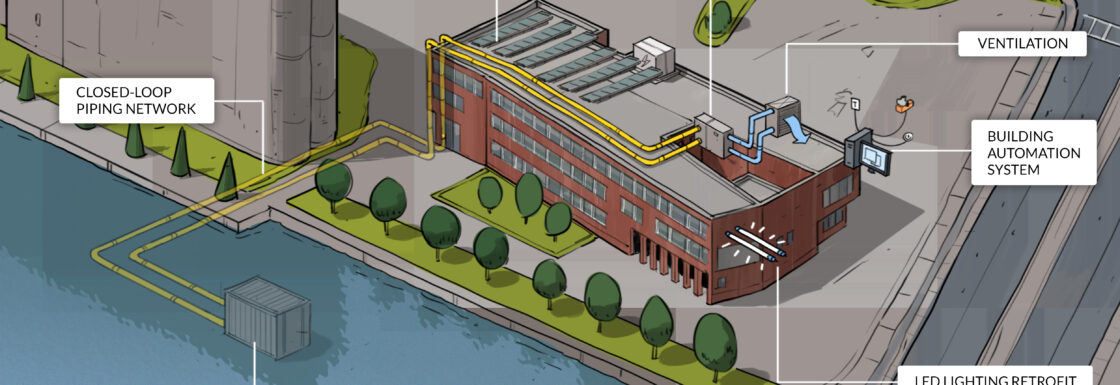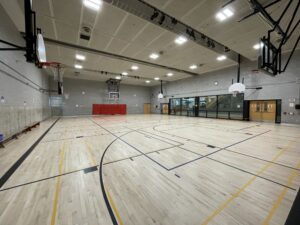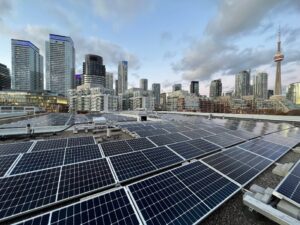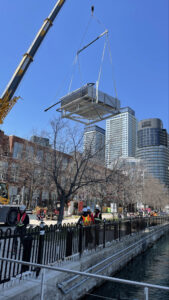Retrofitted Toronto City Waterfront Building uses 71% Less Energy

Projects Sponsor
Toronto’s City Waterfront Building (CWB) serves as a world-class sustainability model for building owners exploring deep reductions to GHG emissions, energy use, and the potential of hydrothermal technology.
Because buildings are the largest source of emissions in the City of Toronto, the skyline needs to be a frontline in the struggle against climate change. Building emissions are primarily generated by the burning of fossil fuels for heating and hot water and reducing them will go a long way towards meeting the goals of the City of Toronto’s TransformTO Net Zero Climate Action Strategy, as well as the City’s ambitious target to reduce community-wide emissions to net-zero by 2040.
To demonstrate leadership and help equip Toronto’s buildings for the future, the City piloted several projects — one of which was the City Waterfront Building (CWB) energy retrofit focused on hydrothermal technology. The project took place over three phases, culminating in a deep energy retrofit — and the results are significant.
The scope of the project was ambitious. The aim was to reduce energy use by at least 40% over 2015 consumption rates while maximizing opportunities for renewable energy, minimizing the use of potable water, and achieving a financial return within a maximum of 20 years.
To start the project off, the vendor’s engineering team modelled the building using energy management software to determine the building’s energy consumption. Along with a thorough analysis of past energy consumption, this allowed the team to right-size the new heating and cooling system. With this information, they looked at the existing context as well as what outcomes the City sought to achieve.

The building’s location, next to Lake Ontario, inspired the city to use the lake itself as a source of heating and cooling. The City’s net-zero target also led the vendor’s design and the use of an electrical power source: heat pumps. With few other lake-based hydrothermal systems in North America to study, the engineering team drew from its own experience with various bodies of water to inform the system design and implementation. They used surface temperature data from the Toronto harbour, along with a thorough understanding of heat pump performance in various conditions. Given the relatively short time frame to implement the retrofit, the team developed rules of thumb for safe ranges, designing the system to work within these rules.
In Stage 1 of the three-stage retrofit, which ran from 2018-2022, an LED lighting retrofit was completed, reducing electrical consumption by approximately 204,222 kWh per year, while also reducing maintenance costs and improving lighting conditions in the building.

During Stage 2, a rooftop solar PV system with energy storage was completed. It includes a 100KW AC solar photovoltaic (PV) system, which offsets about 12% of the building’s electricity usage per year by generating 134,400 kWh of renewable electricity. A 200kWhr lithium-ion battery, connected to the solar PV system, enhances the building’s resiliency by providing energy for the building’s critical loads during power outages. Energy stored in the battery can also be used to reduce the building’s peak electricity demand loads.

Stage 3 was a deep energy retrofit. This includes a closed-loop, lake-based, hydrothermal system that relies solely on electricity to provide 100% of the heating and cooling for the building. This eliminates the need for natural gas and significantly reduces the building’s GHG emissions. The new heating system uses heat pumps instead of gas-fired boilers, producing three times the amount of heat per energy inputted into the system. To support the lower hot water temperature in the new heating system, radiator capacity was increased, and terminal reheat coils were added for many rooms within the building. Finally, a responsive building automation system, together with occupancy sensors, supports temperature and ventilation setbacks in vacant rooms, helping to reduce heating and cooling requirements.
The CWB energy retrofit has achieved transformative results, exceeding the City’s desired outcomes. The building now generates clean, decentralized electricity, uses 71% less energy, and it emits 83% fewer Scope 2 GHG emissions — all while being more comfortable and easier to maintain. Toronto’s City Waterfront Building serves as a world-class sustainability model for building owners exploring deep reductions to GHG emissions, energy use, and the potential of hydrothermal technology.
It’s a great project on a Great Lake and a great start.













